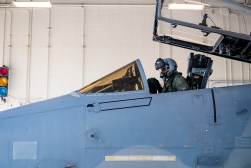This Air Force unit will be critical to enabling JADC2

The Air Force’s new 350th Spectrum Warfare Wing will play a critical role in the Pentagon’s warfighting concept aimed at providing commanders with more and better information to make decisions faster than adversaries.
Joint All-Domain Command and Control (JADC2), as the concept is known, seeks to better connect and correlate sensor data to shooters and decision-makers so they can sense, make sense and act inside the cycle of their adversary on the dynamic battlefield of the future.
Much of the sensing in this future environment exists within the electromagnetic spectrum, putting the new 350th at the tip of the spear.
“We sense almost entirely through the electromagnetic spectrum. There’s no way that you can do JADC2 without the ability to sense. You have to be able to sense accurately,” Col. William Young, the wing’s commander, said in a podcast hosted by the Association of Old Crows this week. “Adversaries will try to contest our ability to sense … We are the organization that is charged with ensuring that our warfighters have the tools that are required to do that sensing in and through the electromagnetic spectrum.”
The 350th Wing was officially created in June 2021 to enable, equip and optimize the fielding of electromagnetic spectrum capabilities.
Young said his organization is singly charged with ensuring systems can be available during times of need in conflict.
“If you look on your operational view one, or your OV1, you’ll find a bunch of lightning bolts. Prior to 25, June of … [2021], there was no single organization that was charged with making sure that those lightning bolts were there in time of conflict,” he said, referencing Department of Defense charts that depict lightning bolts as the connections between capabilities.
“Coming back to JADC2’s process model, if you want to call it that, of sensing, then making sensing and acting, the sensing is almost entirely through the electromagnetic spectrum,” Young said. “The action, once we’ve made sense of things, the action or the direction or the guidance that’s given to integrate and connect all those individual capabilities into a single warfighting entity is delivered through the EMS.”
The wing is also looking to achieve efficiencies throughout the force in an era when budgets are going to be tight. While the military finds itself in the most dynamic strategic environment against the most threats of competitors ever, cost savings and efficiencies will be greatly important.
“In some aspects, an electron is much cheaper than a very expensive missile,” Gen. Charles Brown, chief of staff of the Air Force, said last year. “We’ve got to think about the cost curve” and be able to do both the kinetic and non-kinetic.
The ability to make sense of the data coming from platforms requires engineering of the platforms, which is exactly what the wing does, its commander explained.
Young described how the 350th is working to provide ad hoc and novel kill webs on demand for the Air Force to be able to prosecute a fight at the time of its choosing, both of which require going “beneath the skin” of various platforms or engineering the systems.
“If you look at the nature of ad hoc, that goes to the ability to go beneath the skin of our various platforms and be able to view the individual line replaceable units and increasingly, the reprogrammable multifunction arrays and the software-defined radios that are on all of our platforms and be able to now not be limited to that platform itself,” he said.
This involves taking the software-defined radios and reprogrammable multifunction arrays from two different platforms, and composing them into a new system to support a third, Young said in a hypothetical example, noting that the end system could take sensing capabilities from platform A, and combine that with the sensing capability of platform B to cue platform C.
“The ad hoc nature is based upon the fact that before now, platform C would’ve had to do everything by itself,” he said. “The only way to make platform C more effective in combat would’ve been either upgraded or buy brand new platform C. But you’re just limited by acquisition physics, I’ll call it, in terms of how fast you can get new hardware and how fast you can get new operational flight programs onto the systems.”
This ad hoc approach can be simply distilled by going into platforms to pull together specific capabilities to solve specific tactical problems in the immediate term.
Regarding the novel approach, Young said this involves presenting things to the adversary never before seen.
Here, in the same example, maybe software-defined radios from platforms A and B are combined despite them being on two different airframes and not having worked together before, Young explained.
“Taking sensor data, or sensor engineering data from platform A and Platform B, to be able to provide threat warning for Platform C or targeting data may never have been done before,” he said.




